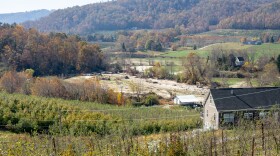Staff at North Carolina State University are asking for the public's help to locate what's known as “witch's brooms” on pine trees – and not the Halloween decorations.
Witch's brooms are abnormal growths in the branches of trees that can be caused by pests, diseases or mutations. On pine trees, they're rounded, compact collections of shorter needles and smaller cones.
NC State researchers with the Tree Improvement Program are looking to sample those needles and cones on loblolly pine trees, one of the most common pine trees in the state.
Tree improvement analyst Nasir Shalizi said the NC State team wants to determine the cause of witch’s brooms in loblolly pines. He said most sampled ones so far have been due to mutations that are largely harmless to the trees. But, seeds from mutated witch's brooms may carry dwarfing traits, which Shalizi said could be useful to researchers.

The Tree Improvement Program aims to grow strong, disease-resistant loblolly pines to strengthen planted forests. Many of these trees are used in seed orchards to mass-produce improved seeds. But Shalizi said that currently, the loblolly pines in their seed orchards can be too tall to reach safely.
“They are not easily accessible,” Shalizi said. “We use bucket lifts to climb the tree and basically do the breeding or collect the cones. So operationally and logistically, it's hard. And also, it poses danger because you have to work with heights.”
Witch’s brooms could then be the solution for less toil and trouble. Shalizi said seeds from witch’s brooms could help grow shorter loblolly pine trees in seed orchards.
The trees grown from witch’s broom seeds can be dwarfed. Shalizi said researchers would graft an improved loblolly pine to the rootstock originating from a dwarfed tree. The grafted tree would then have the root system of a dwarfed tree, making it grow shorter, but the tree would produce seeds with the genetics of the improved loblolly pine. That will make it easier for researchers to care for the trees and access the cones for future tree breeding.
“The other objective is to see if these dwarf rootstocks promote flowering – produce more cones and more seeds,” Shalizi said. “In fruit trees, some of these dwarf stocks produce lots of fruits, so we want to see if it is the same in pine trees.”
The NC State team has identified around 40 loblolly pines with witch's brooms in North Carolina, with plans to sample about 25 this year. A Google form is available online to fill out information relating to more witch's broom locations.
Shalizi said that October is the prime sampling period, as it is the appropriate time to collect cones. Given the short sampling window, Shalizi said newly submitted witch’s broom locations will likely be sampled next fall.







